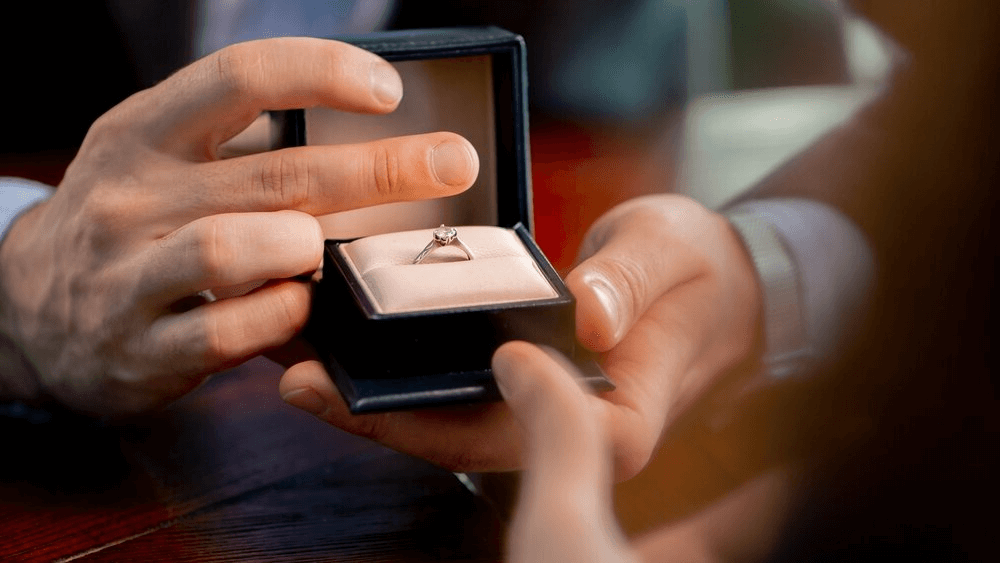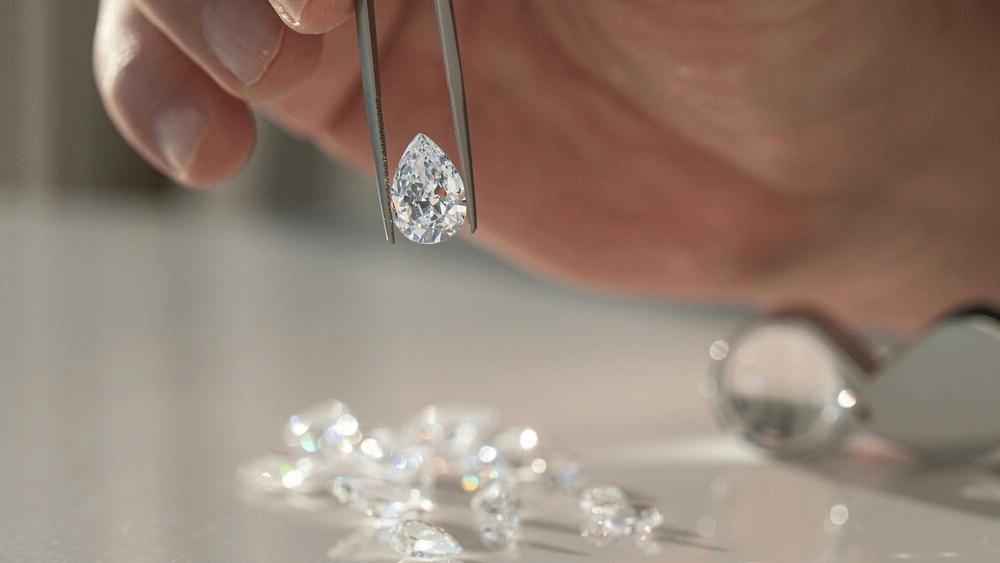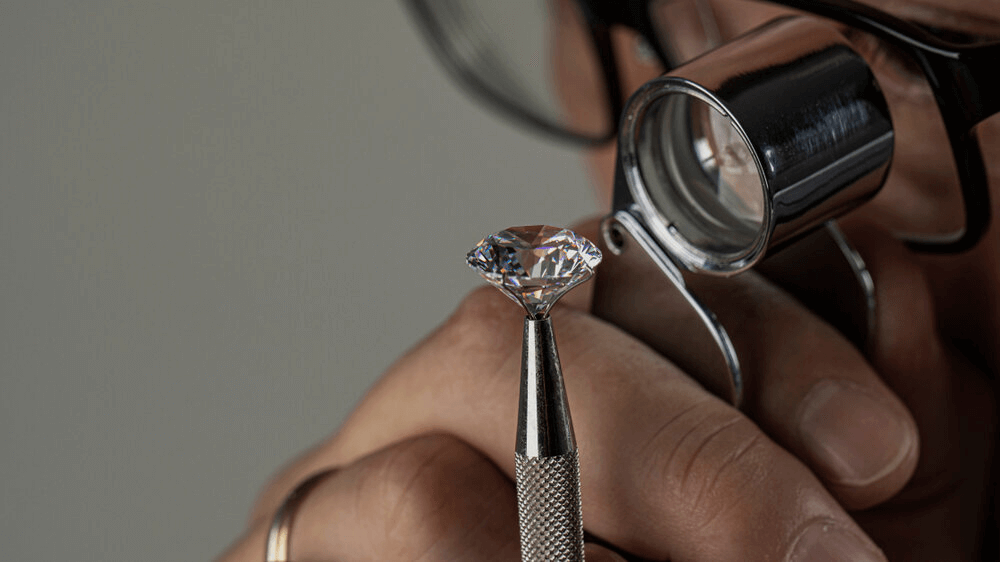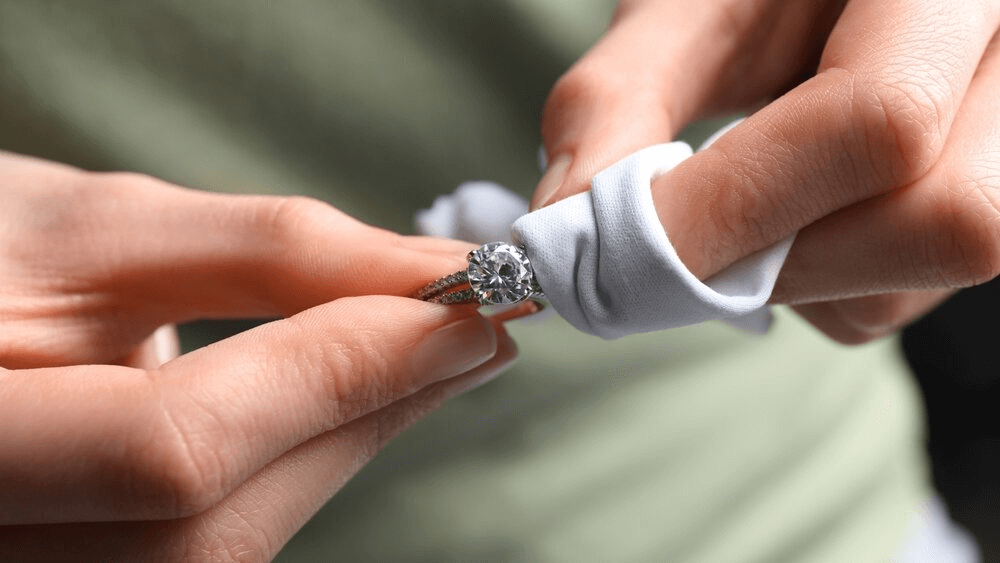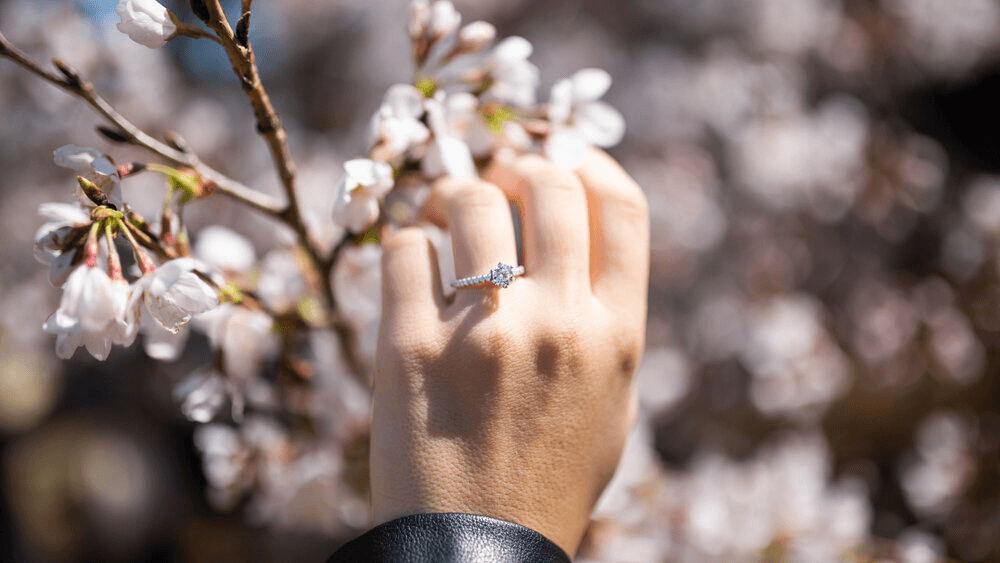Jewelry Marks & Stamps: Unlock the Hidden Secrets!

By Gary A.

Edited by Olivia H.
Published Aug 8, 2024
Edited on Dec 18, 2024
Jewelry marks and stamps can tell you so much about a piece’s quality and history—here’s everything you need to know to decode them with confidence.

Navigate This Guide:
- 6 Quick Tips for Examining Jewelry Marks and Stamp Symbols on Diamond Engagement Rings
- Introduction to Decoding Jewelry Marks and Stamps
- The Enigma and Significance of Hallmarks in Jewelry Buying
- The Historical Journey of Jewelry Markings
- Understanding Metal Content Through Marks
- The Art of Maker’s Marks
- Navigating Special Cases in Jewelry Marks
- Practical Insights: Making Informed Choices
- Our Expert Take: Empowering Your Jewelry Selection
- 10 Frequently Asked Questions about Jewelry Marks and Stamp Symbols
Before we dive deeper into the specifics, here are some practical tips to help guide your decision-making process:
6 Quick Tips for Examining Jewelry Marks and Stamp Symbols on Diamond Engagement Rings
- Tip 1: Scrutinize the Purity Stamp for Metal Content
- Always begin by checking the purity stamps on the ring. These stamps, such as 10K, 14K, 18K, or 24K for gold, and 900 or 950 for platinum, are crucial indicators of the metal’s purity. A “925” stamp signifies sterling silver. Understanding these stamps is essential for assessing the quality and value of the metal in your engagement ring.
- Tip 2: Verify the Authenticity through the Maker’s Mark
- A genuine maker’s mark or hallmark is a sign of authenticity and quality. It’s vital to familiarize yourself with the hallmarks of reputable brands. Ensure that the ring you’re considering has a clear and authentic maker’s mark, as this not only signifies authenticity but can also contribute to the ring’s overall value.
- Tip 3: Be Cautious of Misleading Stamps
- Be aware of stamps like “GF” (Gold Filled), “GP” (Gold Plated), or “GE” (Gold Electroplated). These indicate that the ring is not made of solid gold but is instead coated with a thin layer of gold. Such pieces are generally less valuable than those made from solid gold or other precious metals.
- Tip 4: Consider the Historical Context of Vintage Rings
- When dealing with vintage or antique rings, it’s important to consider that hallmarking standards have evolved over time. Older pieces might not have the same types of stamps as modern jewelry. Researching the specific era of the ring can provide insights into its hallmarking standards and authenticity.
- Tip 5: Watch Out for Altered Stamps
- Be vigilant for signs of altered or added stamps, which can be an attempt to misrepresent a ring’s value. If a stamp appears uneven, freshly engraved, or out of place, it could indicate tampering. Trust your instincts and be cautious of rings with suspicious-looking stamps.
- Tip 6: Understand International Hallmark Variations
- Jewelry from different countries may follow different hallmarking systems. For example, “750” often indicates 18K gold internationally, while “375” is commonly used for 9K gold. When considering an imported piece, it’s important to be familiar with these international standards to accurately assess the metal content and purity of the ring.
Now that you’ve got these practical tips, use Jeweler AI below to find the perfect engagement ring that suits your style and budget:
Introduction to Decoding Jewelry Marks and Stamps
There’s a lot to learn when engagement ring shopping. Not only do you need to know a lot about diamonds – the 4Cs, natural vs lab-grown, authentication – but you also need to know about the full picture: bands, settings, styles, and the type of metal you’re choosing to finish the whole piece.
It might seem a little overwhelming at first, but all in all, it shouldn’t take you too long to get your head around, and pretty quickly, you’ll be walking into jewelers with a pretty complete idea of what to look out for and what’s best to buy. At least until you hold a ring in your hands and notice the tiny marks and stamps engraved on the band. Then everything goes haywire.
The Enigma and Significance of Hallmarks in Jewelry Buying
The first thing we’ll say is: don’t panic. While these tiny markings might seem a little out of the ordinary – with some of them looking like ancient symbols from a bygone era! – there’s usually a very good reason for them. These marks and stamps provide essential information about the ring’s quality and authenticity.
Like laser inscriptions on the diamond itself, they can tell you the metal type and purity, the manufacturer’s identity, or even the place and date of manufacture. By understanding these marks, you can make a far more confident purchase with a clear idea of what you’re buying and whether it meets your standards.
The Historical Journey of Jewelry Markings
This isn’t a new thing. While it might seem like modern technology is required to make such detailed inscriptions in a small piece of metal, jewelry markings have been around for thousands of years, with the first being traced back to Ancient Egypt and Ancient Greece.
In these early cultures, jewelry marking served various purposes, including the indication of metal purity and as a form of decoration or symbolism. When it comes to how they were achieved, ordinarily it would take the eye of a skilled artisan, using a chisel or graver to carve the letters into the surface of the metal. It was pretty intricate work, so you wouldn’t want to distract them!
From Ancient Signatures to Modern Stamps
Onwards from here, hallmarking began to emerge in mediaeval Europe, where guilds and city authorities would regulate the quality and authenticity of jewelry by requiring certain stamps.
In 1327, for instance, the Goldsmith’s Company was granted a royal charter, establishing the London Assay Office and officially formalising hallmarking practices. These practices continued throughout the Renaissance and Baroque periods, seeing various changes during the Industrial Revolution before evolving into the modern hallmarking practices we know today.
The Evolution of Hallmarking Laws
As the method of hallmarking jewelry evolved, so too did the laws associated with the practice. After the Renaissance and Baroque periods, for instance, the international marking industry developed exponentially, creating a need to standardise hallmarking practices to protect consumers.
In the 19th and 20th centuries, hallmarking laws were codified and standardised across the world, with governments enacting regulations to ensure consistent testing – with examples including the International Convention on Hallmarks and the Hallmarking Convention of the European Union. In recent decades, hallmarking laws have been further modernised to adapt to new technological advancements, with laser engraving and electronic certification systems being introduced to enhance efficiency and accuracy.
Understanding Metal Content Through Marks
A lot of the time, marks on an engagement ring will indicate the presence of certain metals, such as gold, silver, or platinum. When it comes to gold, this could be numbers that indicate the carat – such as 14K or 18K – or a number indicating fineness.
To give an example, if the fineness mark is 375, then the alloy must have at least 375 parts gold per 1,000, making it a 9 karat. A mark of 585, then, must indicate a 14 karat metal, 750 an 18 karat metal, and so on. For silver, the standard of metal is 925, which means the ring has at least 92.5% silver mixed with copper to give it strength. For platinum, you’ll likely see an engraving of 950 – or PT950 – indicating it has 95% purity.
The Art of Maker’s Marks
As mentioned before, however, the engraving might include a maker’s mark, which means the engagement ring can be traced back to its creator. This mark typically consists of initials, a logo, or a unique symbol that references the manufacturer. While this is undoubtedly a way for artisanal companies to establish their reputation in the engagement ring field, it also provides some valuable information for collectors and consumers who want to know they are getting quality craftsmanship.
In the engagement ring industry, there are, unfortunately, several companies that will attempt to replicate the work of established jewelers, creating seemingly identical jewelry pieces only with less quality and durability. At first glance, these pieces might be hard to distinguish, but with a maker mark, buyers can be assured of the ring’s authentication, certification, and overall value.
Navigating Special Cases in Jewelry Marks
At the beginning of this article, we talked about how noticing these markings might seem a little confusing at first but you can hopefully see how easy it is to understand them. That isn’t to say there won’t be any special instances, however. Not all markings and stamps are going to follow a basic pattern, especially if you’re looking at an engagement ring that has been around for a long time.
Vintage and Antique Jewelry Marks
If you have picked up a piece of vintage and antique jewelry, there’s a chance that it may have markings that follow different conventions compared to modern pieces. Many vintage rings, for instance, feature date marks indicating the year of manufacture. These marks are particularly common in regions with established hallmarking systems, such as England or France, where dates were used to denote the year the piece was assayed.
Provenance marks can also indicate previous owners or significant events, engraved years ago to add to the story and allure of the ring. Even now, many people will engrave their rings – or even diamonds – with individual messages, such as the name of the wearer or the date of a special occasion, looking to enhance the sentimental value and uniqueness through personalised messages.
Practical Insights: Making Informed Choices
With all of this in mind, it’s important to take into account the markings and stamps on an engagement ring and make an informed choice if you’re thinking about buying it. This includes knowing how to verify the authenticity and understanding the impact of marks on the overall value.
Understanding the Impact of Marks on Value
You should also be aware of how the markings might impact the overall value. A stamp indicating the metal content and purity, for instance, will typically command higher prices due to their intrinsic value and durability, as well as the authentication that has come with verification.
Provenance marks can also raise the price of any given ring, as they provide valuable insights into its age, origin, and previous ownership. This can go the other way too, it should be noted. While most old rings will have appreciated in value, an old, perhaps individually messaged, provenance mark – which may not reach the same standards of today’s markings – might lower the price, making it a worse ring to invest in long-term.
Our Expert Take: Empowering Your Jewelry Selection
You already know a lot about engagement ring shopping, and markings are just another thing to learn. Upon looking at an engraving, it’s important to do everything you can to verify its meaning and work with a jeweler to ascertain the authenticity and the impact on value.
If it’s a simple metal engraving, make sure you remember what the numbers mean, and try to look out for bands with a higher karat – although the carat weight might have to be balanced out if you’re spending the majority of your budget on a diamond with higher 4C grading. And if it’s a metal engraving with a personalised message, try to understand what that means in terms of price.
There might be many more engagement ring details that will pop up while shopping, but the important thing to know is that this is a continuous learning process. Every day there might be something new, but hopefully, engagement ring hallmarks and their meaning are now a lesson completed!
10 Frequently Asked Questions about Jewelry Marks and Stamp Symbols
- Q: What do the numbers on my jewelry mean?
- A: The numbers stamped on jewelry, such as 925 on silver or 750 on gold, indicate the metal’s purity. For example, 925 means the piece is made of 92.5% sterling silver, while 750 indicates 75% gold purity, equivalent to 18K gold.
- Q: How can I tell if my jewelry is real gold or silver?
- A: Real gold jewelry is typically marked with stamps like 10K, 14K, 18K, or 24K, and real silver is often stamped with “925,” “Ster,” or “Sterling.” These marks, along with a professional assessment, can help determine authenticity.
- Q: What does a “925” stamp mean on jewelry?
- A: A “925” stamp on jewelry signifies that the piece is made of sterling silver, which is 92.5% pure silver mixed with other metals for strength.
- Q: Can jewelry have more than one stamp or mark?
- A: Yes, jewelry can have multiple stamps indicating the metal purity, the manufacturer’s mark, and sometimes the country of origin or designer’s initials.
- Q: What does it mean if there’s no hallmark on my gold ring?
- A: The absence of a hallmark can mean several things: the piece is very old and the mark has worn off, it’s from a country with different hallmarking standards, or it may not be made of precious metal. Further testing by a professional can clarify.
- Q: Are all maker’s marks the same on jewelry?
- A: No, maker’s marks vary widely depending on the designer or manufacturer. They can include logos, initials, or unique symbols and are used to identify the maker of the piece.
- Q: How do I identify a maker’s mark I don’t recognize?
- A: You can use jewelry marks reference books, online databases, or consult with a professional jeweler or appraiser to identify unfamiliar maker’s marks.
- Q: What does a stamp of “GF” or “GP” mean on jewelry?
- A: “GF” stands for gold-filled, and “GP” means gold-plated. Both indicate that the jewelry is not solid gold; instead, it has a layer of gold over a base metal.
- Q: Is platinum jewelry marked differently than gold and silver?
- A: Yes, platinum jewelry is often marked with stamps like “950,” “900,” or “Pt” to indicate its purity, with “950” being the most common mark for high-purity platinum.
- Q: Can I rely solely on the stamp to determine a piece’s value?
- A: While stamps provide valuable information about metal content, they are just one factor in determining value. The overall craftsmanship, gemstone quality, and market demand also significantly impact a piece’s worth.
Discover your perfect ring with Jeweler AI – decode jewelry marks effortlessly!
FOLLOW-UP GUIDE SERIES







